Seasonal Variability of the Acoustic Climate of Ski Resorts in the Aosta Valley Territory
Abstract
1. Introduction
- Firstly, to contribute to the knowledge on the characterization of the seasonal variations of the acoustic climate of three tourist resorts in Valtournenche, which is one of the main side valleys of the Aosta Valley. Valtournenche is crossed by the Marmore stream, which springs from the glaciers at the foot of one of the highest and most famous peaks in the Alps, the Matterhorn (named Cervino in Italian). The popularity of the valley is due to the presence of one of the most renowned ski areas in the western Alps (Cervino Ski Paradise), and to the possibility of practicing a variety of sports activities related to the mountain environment, such as climbing (the top of the Matterhorn represent one of the most popular international goals), trekking, hiking, and mountain biking in summer, ski mountaineering, and walking with snow rackets in winter.
- Secondly, to develop a method for the acoustic characterization of ski resorts through the identification of indicators that would be suitable to apply to the detected sound levels. The method could then be extended to other areas in the open countryside, as required by the European Noise Directive (END). Sound pressure levels were measured during the study to evaluate the seasonal variability of the acoustic climate in the selected areas. The acoustic quality of the areas was quantified through the harmonica index, IH [9], whose definition is provided in Section 2.7. The IH index, which is dimensionless and easy to interpret, even by non-technical operators, can be used to qualify the sound climate of an area over a scale ranging from zero to ten, taking into account the measured LAeq and LA95eq energy levels [10].
2. Materials and Methods
2.1. The Study Sites
- Breuil-Cervinia is the most famous hamlet in Valtournenche; located at 2050m above sea level at the foot of the Matterhorn, it has 700 residents and offers a complete range of tourism activities, that is, heli-skiing, mountain biking, mountain climbing, and sonorous events. It is a very popular tourist resort in both winter and summer, with the presence of vehicular traffic, accommodation infrastructures and ski lifts starting from the center of the village and reaching the Plateau Rosà glacier at an altitude of 3500 m. The Breuil-Cervinia, Valtournenche and Zermatt area is one of the largest skiing areas in the Alps, with a varied “domaine skiable” which passes through three valleys in two countries, Italy and Switzerland, from the 3.883 m of the Piccolo Cervino down to the 1.524 m of the Valtournenche village.
- Chamois is the only car-free town in mainland Italy, and it can only be reached on foot, by bike or by cableway; it is an oasis of peace and quiet, and its environmentally friendly policy makes this little alpine village overlooking the Matterhorn unique. The winter season in the Chamois ski area is a pleasant surprise for snow lovers, with more than 17 km of runs and its breath-taking view over the Matterhorn and snow-clad Alps.
- Cheneil, which is just a few kilometres away from Breuil-Cervinia and Valtournenche, is a small village in the Valtournenche municipality. The Cheneil basin is one of the few inhabited areas of the Aosta Valley that cannot be reached by car, but only on foot or by bike and, for a few years now, by a small and silent panoramic elevator that leads directly to the village. There are no ski lifts in the Cheneil basin. Ski mountaineering is practiced along the valley slopes in winter, and Cheneil is a destination for tourists who seek tranquility, or practice trekking and mountain climbing throughout the year. As a result of its remarkable territorial and urban integrity, Cheneil has maintained an unaltered and unique charm. It borders on the Chamois municipality, from which it can be reached on foot, by bike or on skis.
2.2. Measurement Areas
2.3. Georeferencing and Characteristics of the Measurement Points
2.3.1. Chamois Village Area
2.3.2. Chamois Ski Area
2.3.3. Cheneil Area
2.3.4. The Breuil-Cervinia Area
2.3.5. The Breuil-Cervinia Ski Area
2.4. Acoustic Classifications of the Municipalities with Regard to the Territorial and Infrastructure Characteristics
2.5. The Case Study: Measurement Methodology and Data Processing
2.5.1. Measurement Methodology
2.5.2. Meteorological Conditions During the Measurements and Data Validation
2.6. The Study: Data Processing
2.6.1. Homogenization of the Data for Processing
2.6.2. Data Analysis Based on the Main Detected Acoustic Parameters
2.7. The Harmonica Index Applied to the Measured Levels
- It takes into account both background sound pressure levels and peak levels due to events that occur on it and can easily be calculated from the LAeq and LA95eq parameters that all sound level meters can acquire.
- It can easily be understood by the general public because it is expressed as a number on a scale from 0 to 10, without the use of decibels, in order to make it easy to understand.
- It can be calculated for any time period (hourly, daily, monthly, etc.).
Classification of the Acoustic Quality of Different Areas and Comparison with the Threshold Value
- Green indicates that the noise level is below 4 during the day and below 3 at night, that is, a level of 45 dBA at which WHO states noise is likely to disturb sleep;
- Yellow shows the index is between 4 and 8 during the day, and between 3 and 7 at night;
- Red appears if the index is greater than or equal to 8 during the day, and 7 at night. These levels can be achieved for constant levels of 70 dBA and 65 dBA, respectively, which are widely recognized in Europe as being the critical thresholds for exposure to noise.
3. Results
3.1. Acoustic Characterisation of Different Seasons Based on the Phonometric Parameters
3.2. The Harmonica Index Calculated from the Measured Levels in the Differents Sites
4. Discussion
5. Conclusions
- The three tourist resorts of Chamois, Cheneil and Breuil-Cervinia, although having similar landscape features, have a different soundscape, depending on the period of year and on the presence of tourists.
- Seasonal acoustic climate alterations were evident in all the studied areas and are due to the contribution of both natural sources (streams, insects, animals, etc.) and to noisy human events that do not normally take place in a natural mountain environment, but which are linked to the skiing activity of people from all over the world. Music in bars or pubs, ski lift operations, the maintenance of ski slopes, artificial snowmaking, helicopters to deliver supplies to alpine shelters or for heli-skiing transport, are typical examples of such noise sources.
Author Contributions
Funding
Acknowledgments
Conflicts of Interest
References
- LEGGE. Legge quadro sull’inquinamento acustico N. 447 del 26 ottobre 1995. Suppl. Ordin. n. 125 della Gazz. Uff. Repubb. Ital. Ser. Gen. 1995, 254, 5–14. Available online: https://www.minambiente.it/sites/default/files/legge_26_10_95_447.pdf (accessed on 21 February 2020).
- Working Group of Authorities Concerned with Noise. Acoustic Quality in Natural and Cultural Environments—Proposal for Metrics, Indicators and Auditing Methods; Working Group of Authorities Concerned with Noise: Stockholm, Sweden, 2002. [Google Scholar]
- Kephalopoulos, S.; Paviotti, M.; Anfosso-Lédée, F.; Van Maercke, D.; Shilton, S.; Jones, N. Advances in the development of common noise assessment methods in Europe: The CNOSSOS-EU framework for strategic environmental noise mapping. Sci. Total Environ. 2014, 482–483, 400–410. [Google Scholar] [CrossRef] [PubMed]
- European Commission. Report from the Commission to the European Parliament and the Council on the Implementation of the Environmental Noise Directive in Accordance with Article 11 of Directive 2002/49/EC in COM/2017/0151 Final; European Commission: Brussels, Belgium, 2017. [Google Scholar]
- Aletta, F.; Kang, J.; Axelsson, Ö. Soundscape descriptors and a conceptual framework for developing predictive soundscape models. Landsc. Urban Plan. 2016, 149, 65–74. [Google Scholar] [CrossRef]
- Agnesod, G.; Tibone, C.; Tartin, C. Acoustical Characterization of Mountain Resorts; ICA Publications: Rome, Italy, 2001. [Google Scholar]
- Agnesod, G.; Tibone, C.; Tartin, C.; Crea, D.; Berlier, F. High naturalness alpine areas acoustical characterization in Aosta Valley. In Proceedings of the 6th European Conference on Noise Control, Tampere, Finland, 30 May–1 June 2006. [Google Scholar]
- Vanat, L. International Report on Snow and Mountain Tourism. Available online: http://www.vanat.ch (accessed on 21 February 2020).
- Noise in EU—Le Bruit en Europe. Available online: http://www.noiseineu.eu (accessed on 21 February 2020).
- Mietlicki, C.; Mietlicki, F.; Ribeiro, C.; Gaudibert, P.; Vincent, B. Soundscape and Noise Observatory of Greater Lyons, France, The HARMONICA project, new tools to assess environmental noise and better inform the public. In Proceedings of the EEA Forum Acusticum, Krakow, Poland, 7–12 September 2014. [Google Scholar]
- European Environment Agency. Good Practice Guide on Quiet Areas; EEA Technical Report No 4/2014; European Environment Agency: Copenhagen, Denmark, 2014; ISBN 978-92-9213-424-2. [Google Scholar]
- Cervino Ski Paradise—Valtournenche. Available online: https://www.cervinia.it/ (accessed on 21 February 2020).
- Cervino Ski Paradise—Valtournenche. Available online: https://www.cervinia.it/it/inverno/skirama (accessed on 21 February 2020).
- Steiger, R.; Mayer, M. Snowmaking and climate change future options for snow production in Tyrolean ski resorts. Mt. Res. Dev. 2008, 28, 292–298. [Google Scholar] [CrossRef]
- Decreto del Presidente del Consiglio dei Ministri sulla determinazione dei valori limite delle sorgenti sonore. Gazzetta Ufficiale, Serie Generale n. 280 del 01-12-1997, 7–9. Available online: https://www.gazzettaufficiale.it/atto/serie_generale/caricaDettaglioAtto/originario?atto.dataPubblicazioneGazzetta=1997-12-01&atto.codiceRedazionale=097A9602 (accessed on 21 February 2020).
- Regione Autonoma Valle d’Aosta—Deliberazione di Giunta Regionale n. 2083 del 2 novembre 2012, Approvazione delle disposizioni attuative della legge regionale 30 giugno 2009, n. 20 recante “Nuove disposizioni in materia di prevenzione e riduzione dell’inquinamento acustico. Abrogazione della legge regionale 29 marzo 2006, n. 9” di cui all’art. 2 comma 1, lettere a), b), d) e g). Bollettino ufficiale della Regione Autonoma della Valle d’Aosta n. 49 del 27/11/2012, Reg. Aosta Val. Bull. 2012, 49, 3977–3978.
- Bartalucci, C.; Borchi, F.; Carfagni, M.; Governi, L.; Weber, M.; Wolfert, H. Quiet areas definition and management in action plans: General overview. In Proceedings of the Internoise 2012—41th International Conference and Exposition on Noise Control Engineering, New York, NY, USA, 19–22 August 2012; Institute of Noise Control Engineering: New York, NY, USA, 2012. [Google Scholar]
- Brambilla, G.; Carretti, M.R.; Mangione, M. Caratterizzazione del rumore ambientale: Importanza del campionamento nel tempo. In Proceedings of the AIA Congress, Padova, Italy, 31 March–2 April 1993; pp. 305–310. [Google Scholar]
- Brambilla, G.; Carletti, E.; Carretti, M.R. Procedura per la stima del livello LAeq a tempi brevi in base alla tipologia di traffico urbano. Riv. Ital. Acust. 1996, 20, 29–35. [Google Scholar]
- Centro Funzionale Regione Valle D’Aosta—Meteo CF VDA. Available online: http://cf.regione.vda.it/ (accessed on 21 February 2020).
- OASI—Osservazioni Ambientali della Stazione Internazionale di monitoraggio del Plateau Rosa. Available online: http://oasi.rse-web.it/ (accessed on 21 February 2020).
- Bruitparif—Centre D’évaluation Technique de L’environnement Sonore. Available online: https://www.bruitparif.fr/ (accessed on 21 February 2020).
- World Health Organization. Environmental Noise Guidelines for the European Region; Publications WHO Regional Office for Europe: Copenhagen, Denmark, 2018; ISBN 978 92 890 5356. [Google Scholar]
- Tibone, C.; Crea, D.; Tartin, C.; Berlier, F.; Agnesod, G.; Cappio Borlino, M.; Tabozzi, G.; Delponte, L. Approccio alla caratterizzazione delle aree naturali di montagna: 1996–2018. In Proceedings of the AIA Congress, Aosta, Italy, 20–22 June 2018; ISBN 978-88-88942-57-5. [Google Scholar]
- Brambilla, G.; Gallo, V. QUIETE: A scheme for a new index of the environmental quality of green areas. Noise Mapp. 2016, 3, 49–58. [Google Scholar] [CrossRef]
- Puyana Romero, V.; Brambilla, G.; di Gabriele, M.; Gallo, V.; Maffei, L. The influence of the soundscape on the tourists’ environmental quality perception. In Proceedings of the Euronoise, Maastricht, The Netherlands, 31 May–3 June 2015. [Google Scholar]
- Brambilla, G.; Maffei, L. Responses to Noise in Urban Parks and in Rural Quiet Areas. Acta Acust. United Acust. 2006, 92, 881–886. [Google Scholar]
- Fastl, H.; Zwicker, E. Psychoacoustics—Facts and Models; Springer: Berlin/Heidelberg, Germany, 1990. [Google Scholar]
- Yang, M.; Kang, J. Psychoacoustical evaluation of natural and urban sounds in soundscapes. J. Acoust. Soc. Am. 2013, 134, 840–851. [Google Scholar] [CrossRef] [PubMed]
- Kang, J.; Aletta, F.; Gjestland, T.T.; Brown, L.A.; Botteldooren, D.; Schulte-Fortkamp, B.; Lavia, L. Ten questions on the soundscapes of the built environment. Build. Environ. 2016, 108, 284–294. [Google Scholar] [CrossRef]
- European Environment Agency. Quiet Areas in Europe, the Environment Unaffected by Noise Pollution; EEA Technical Report 14/2016; European Environment Agency: Copenhagen, Denmark, 2016; ISBN 978-92-9213-745. [Google Scholar]
- Rixen, C.; Rolando, A. The Impacts of Skiing and Related Winter Recreational Activities on Mountain Environments; Bentham Science Publisher: Sharjah, UAE, 2013; ISBN 978-1-60805-632-3. [Google Scholar]
- Radicchi, A. Mobile applications for environmental noise and soundscape evaluation. In Proceedings of the INTER-NOISE and NOISE-CON Congress, InterNoise19, Madrid, Spain, 16–19 June 2019; pp. 3993–4001. [Google Scholar]
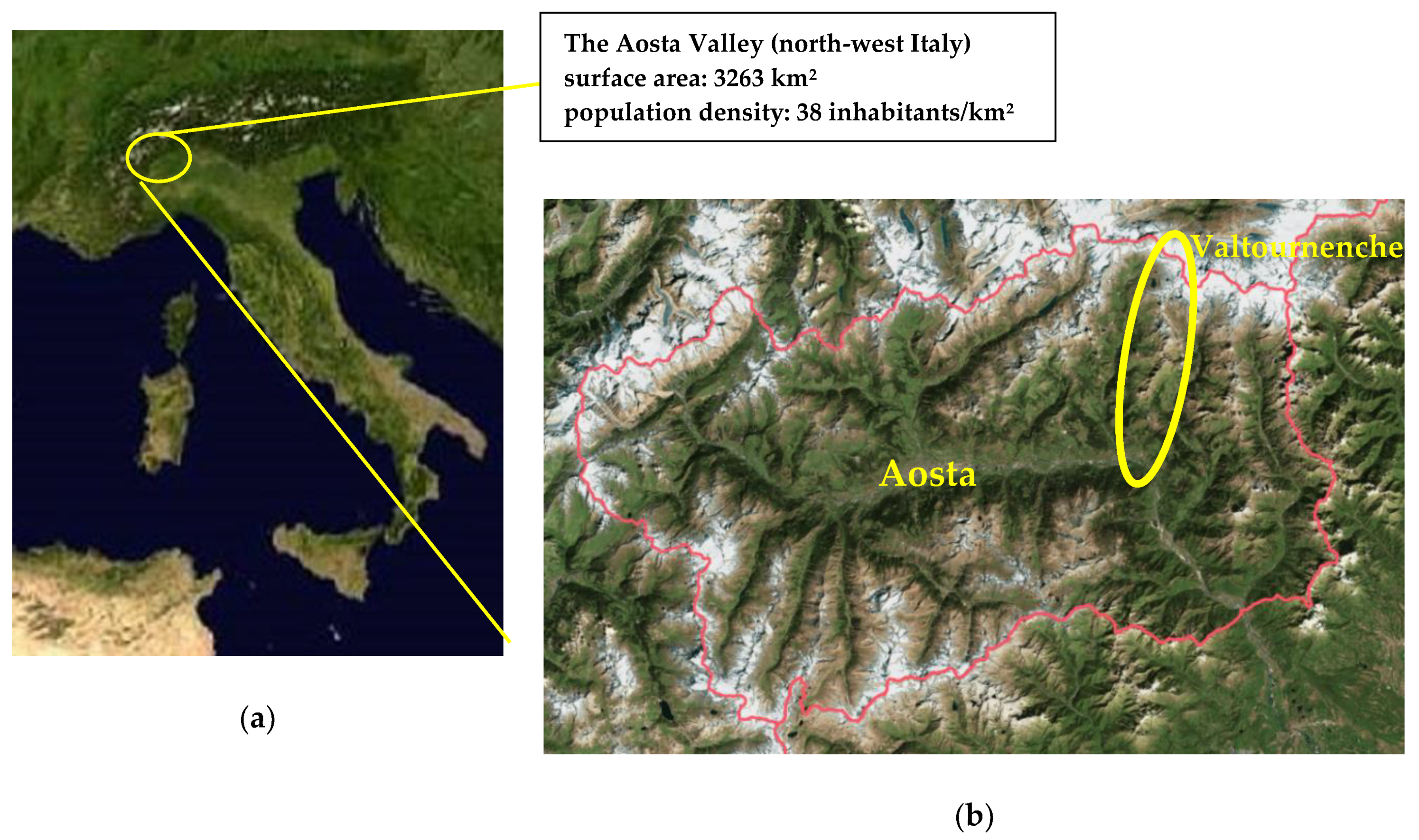
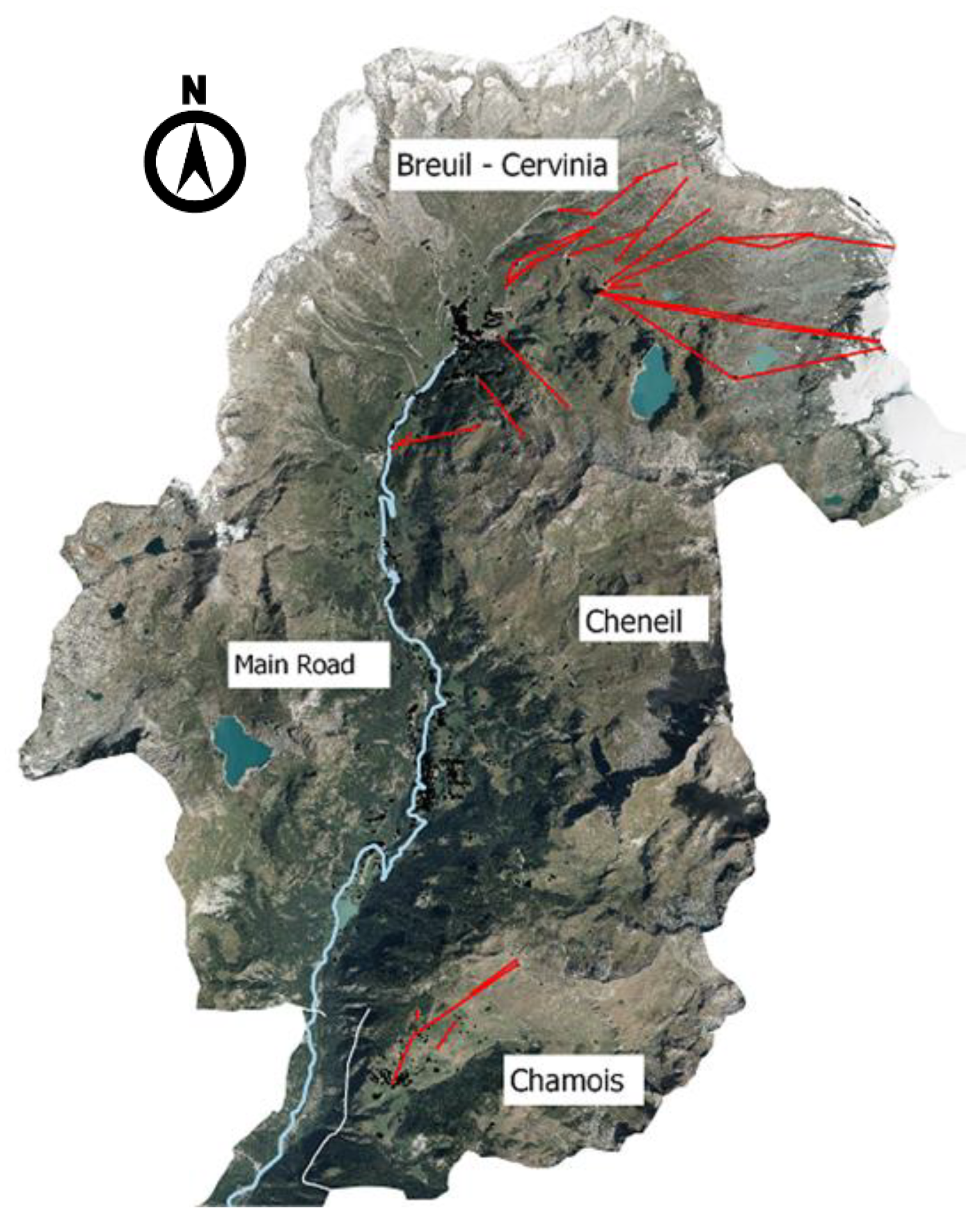
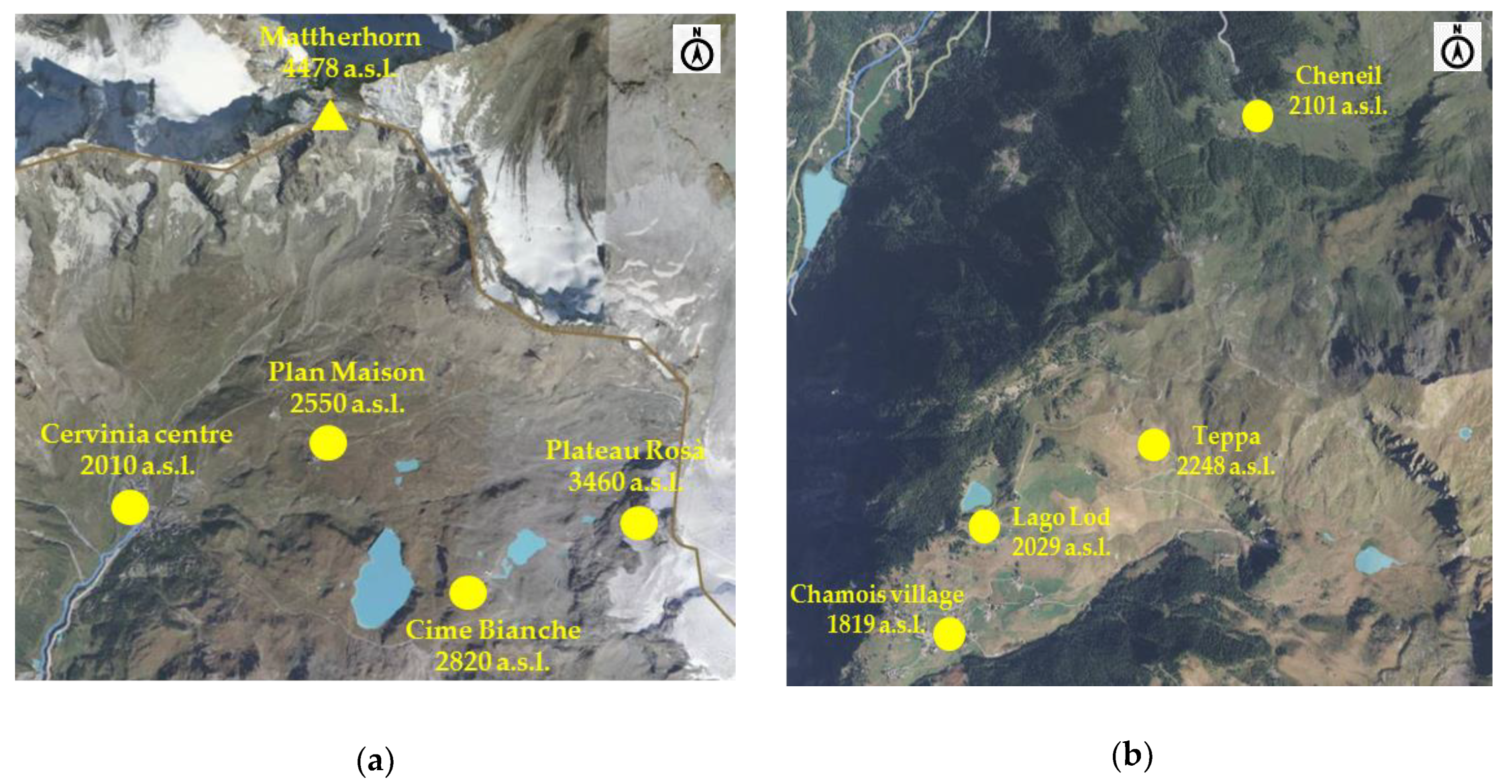
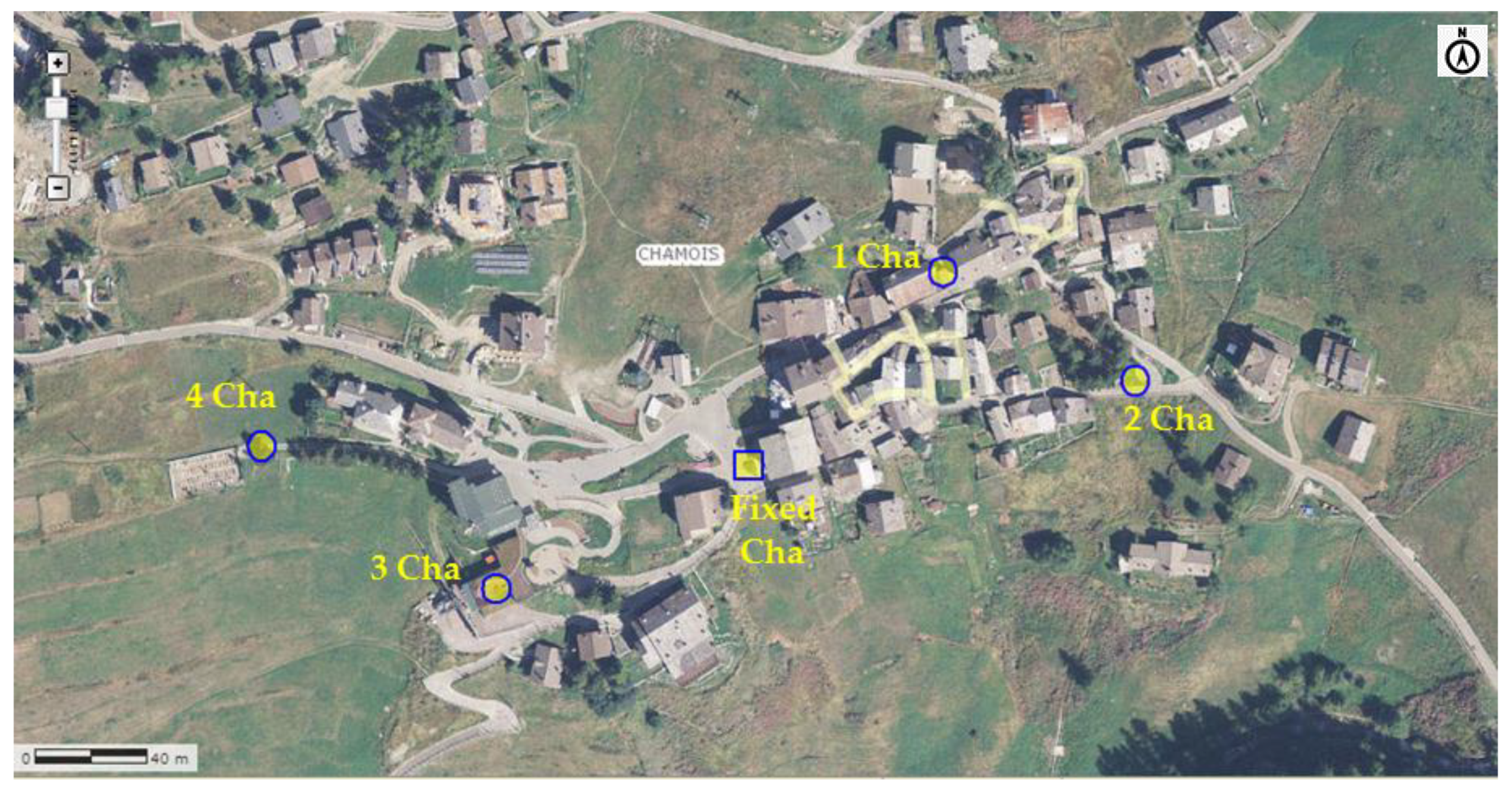
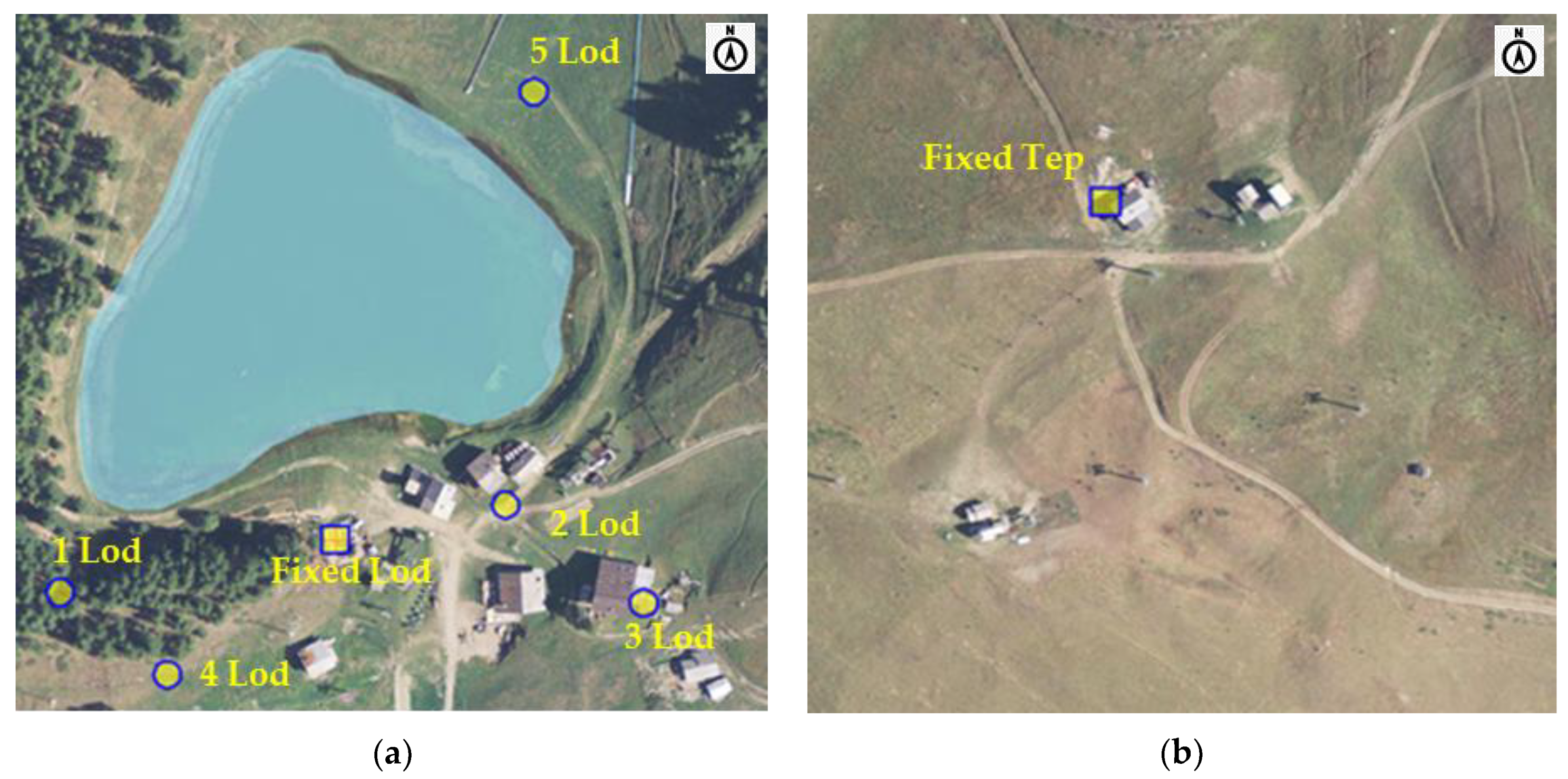
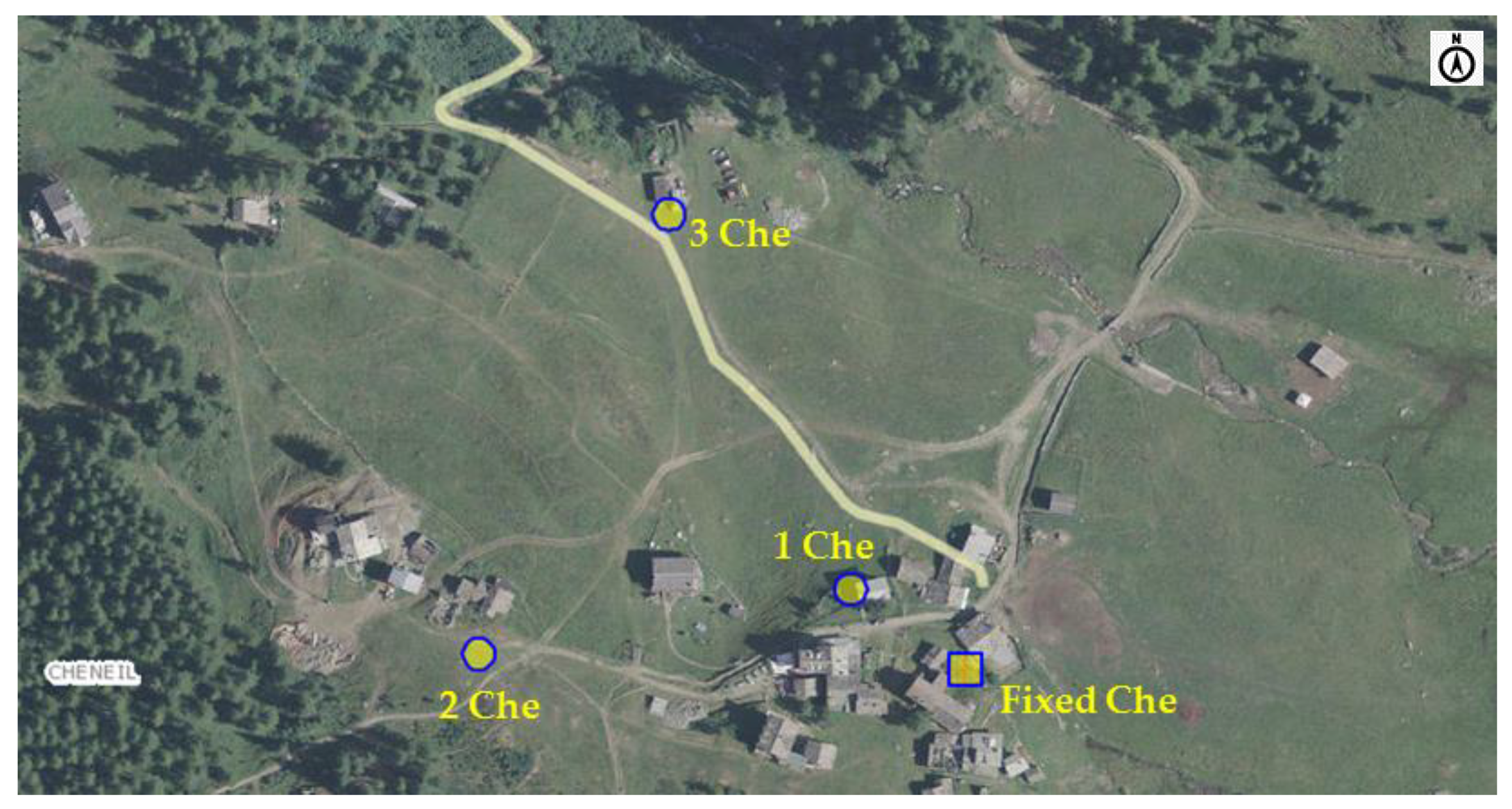
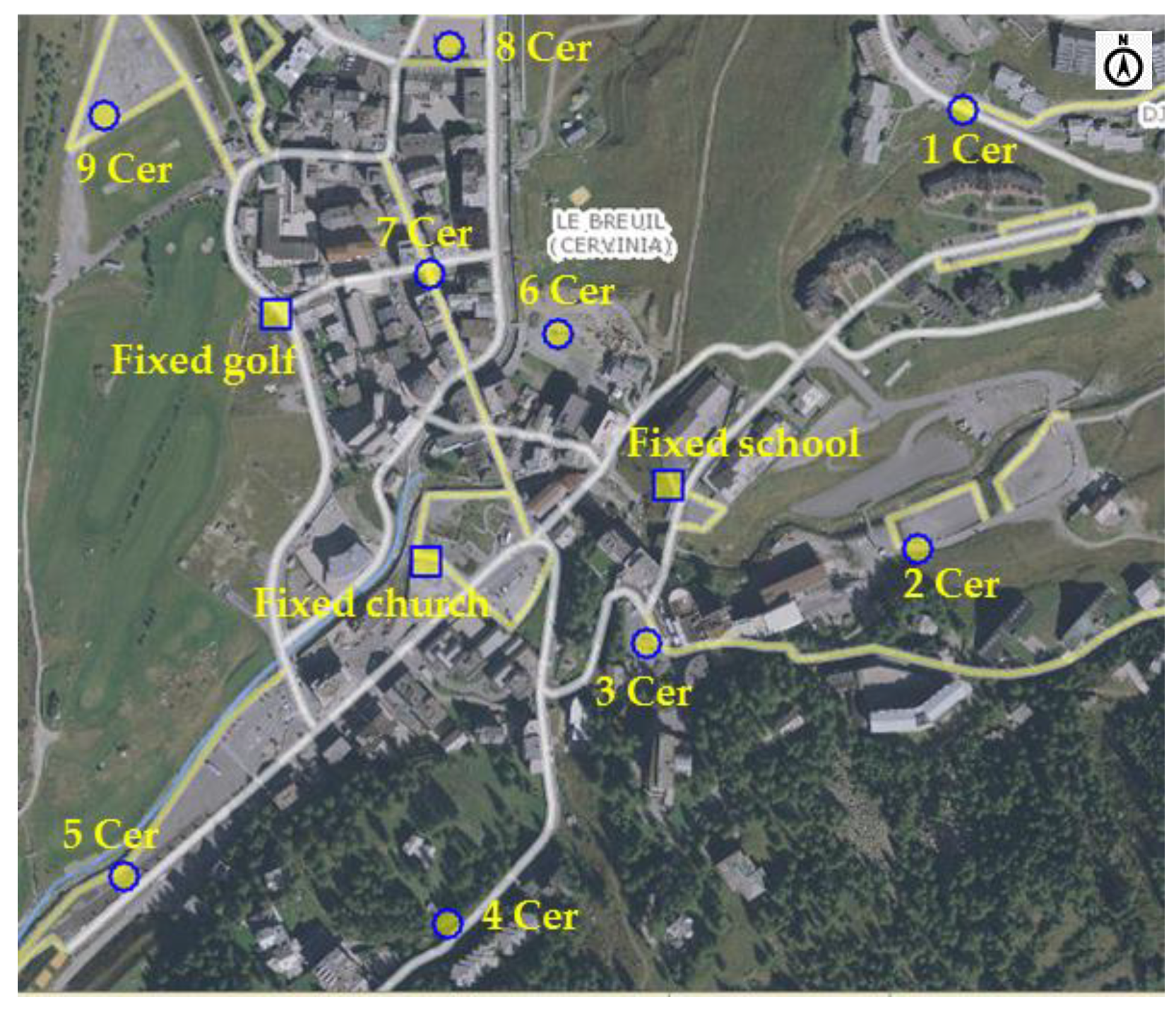
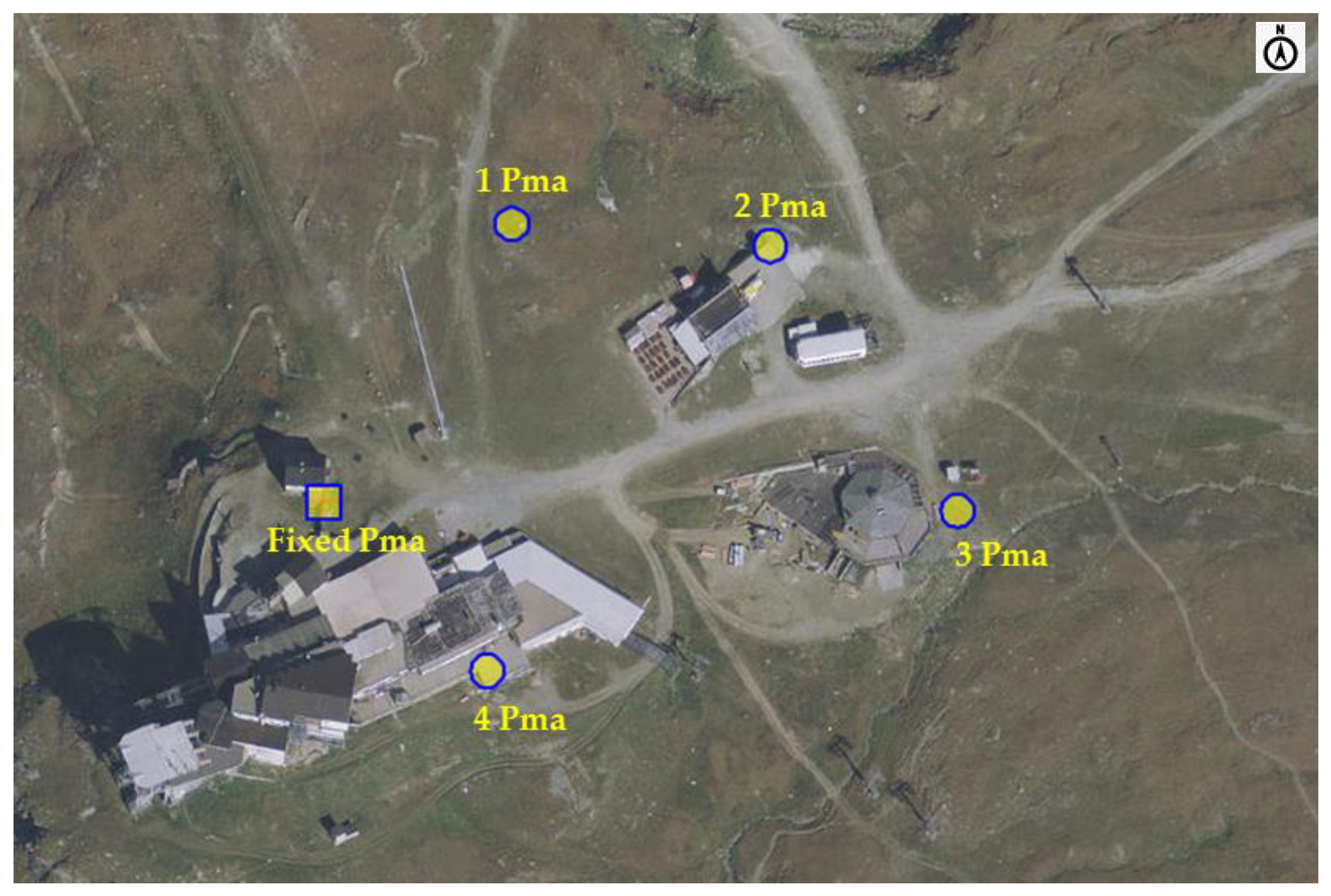
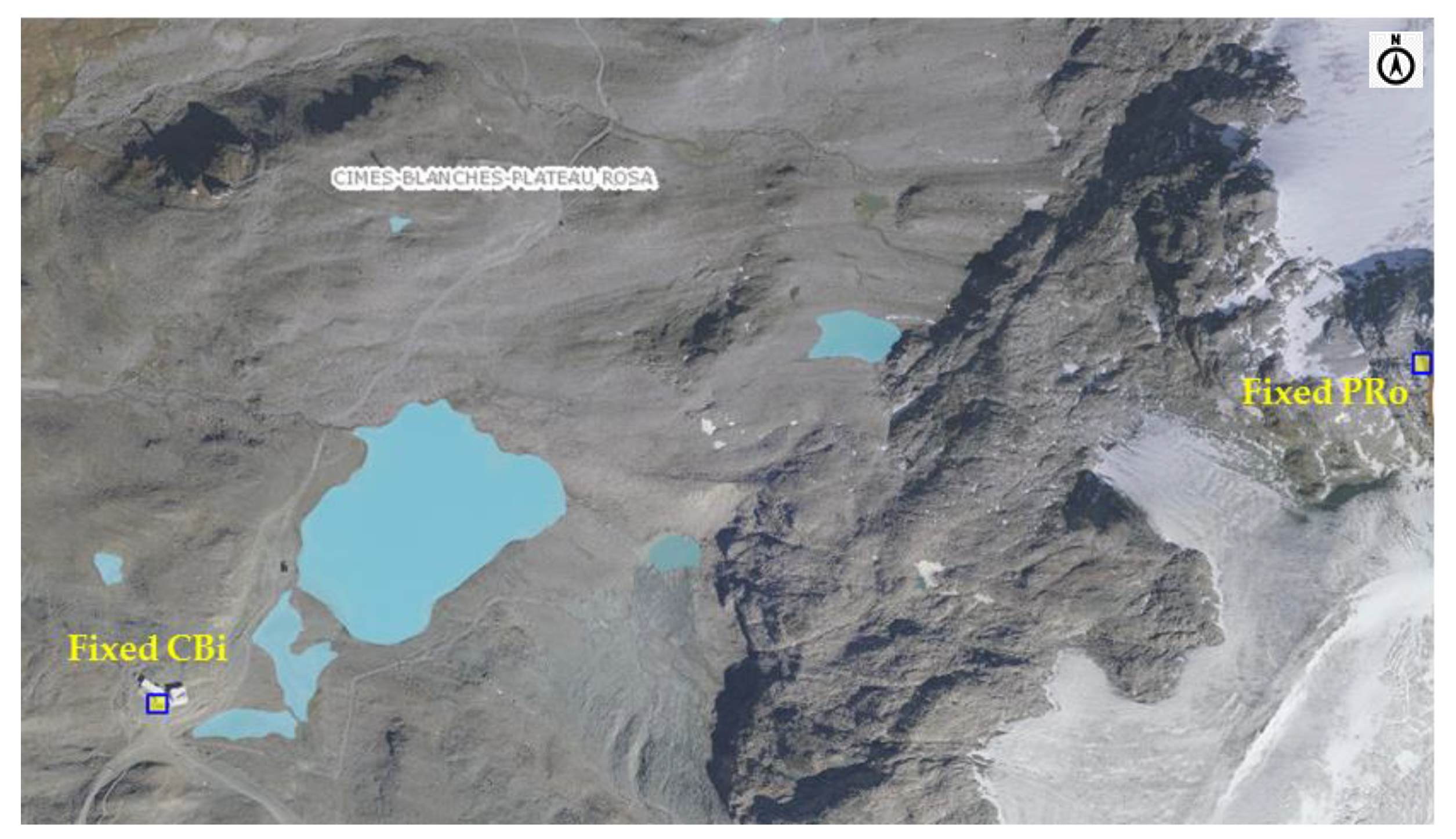
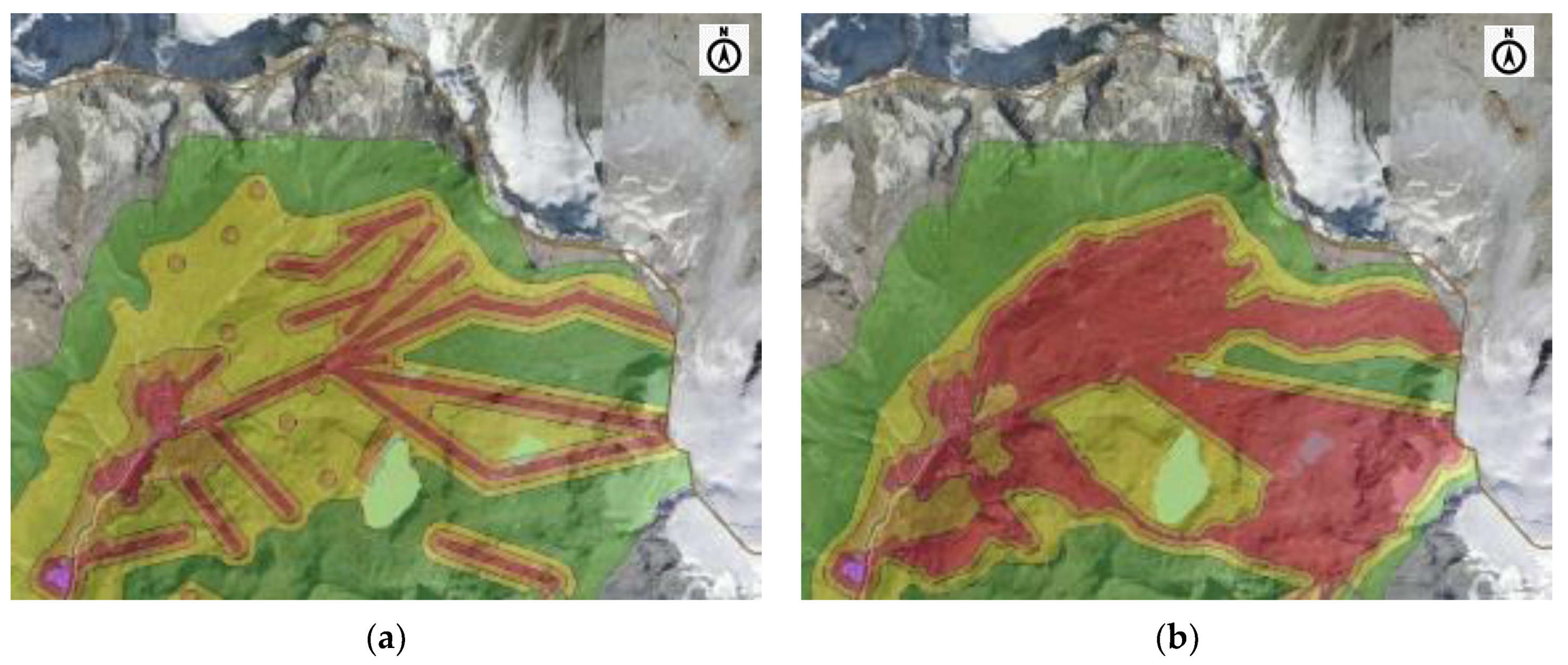
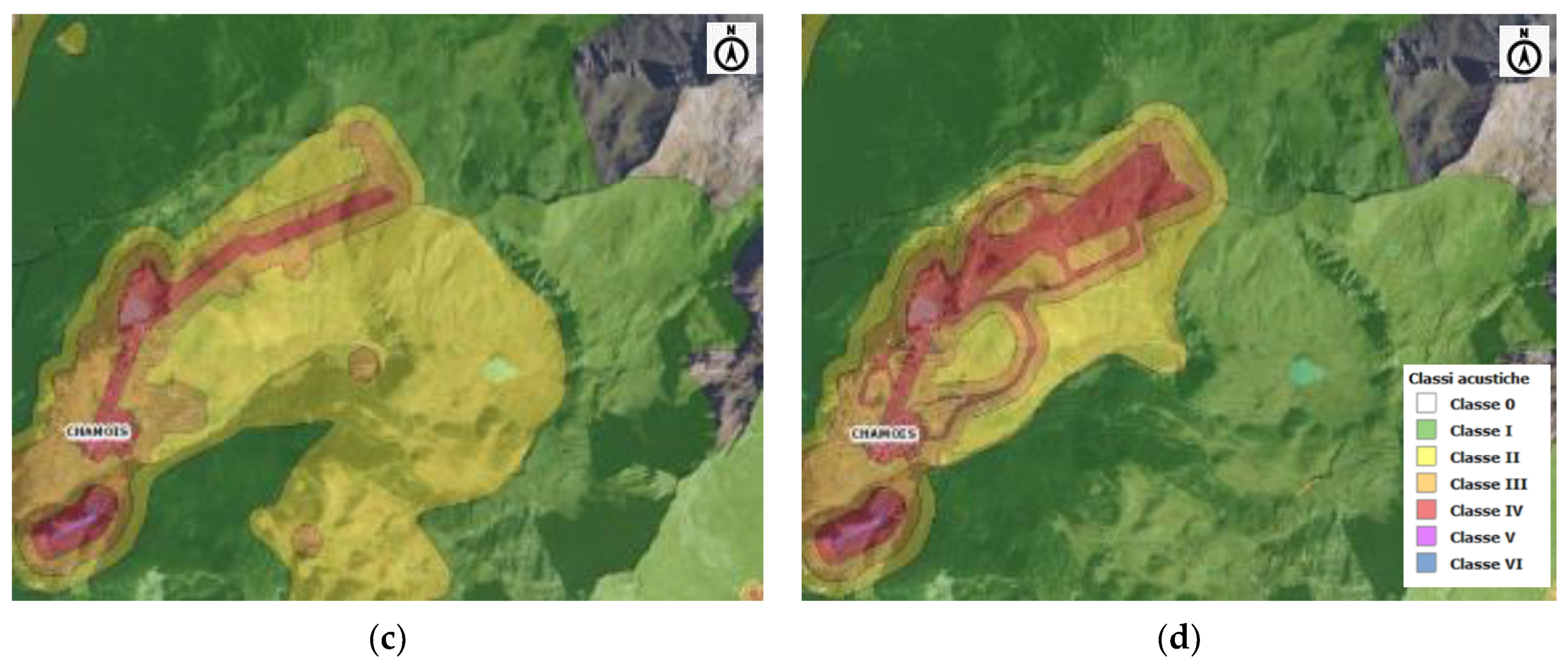
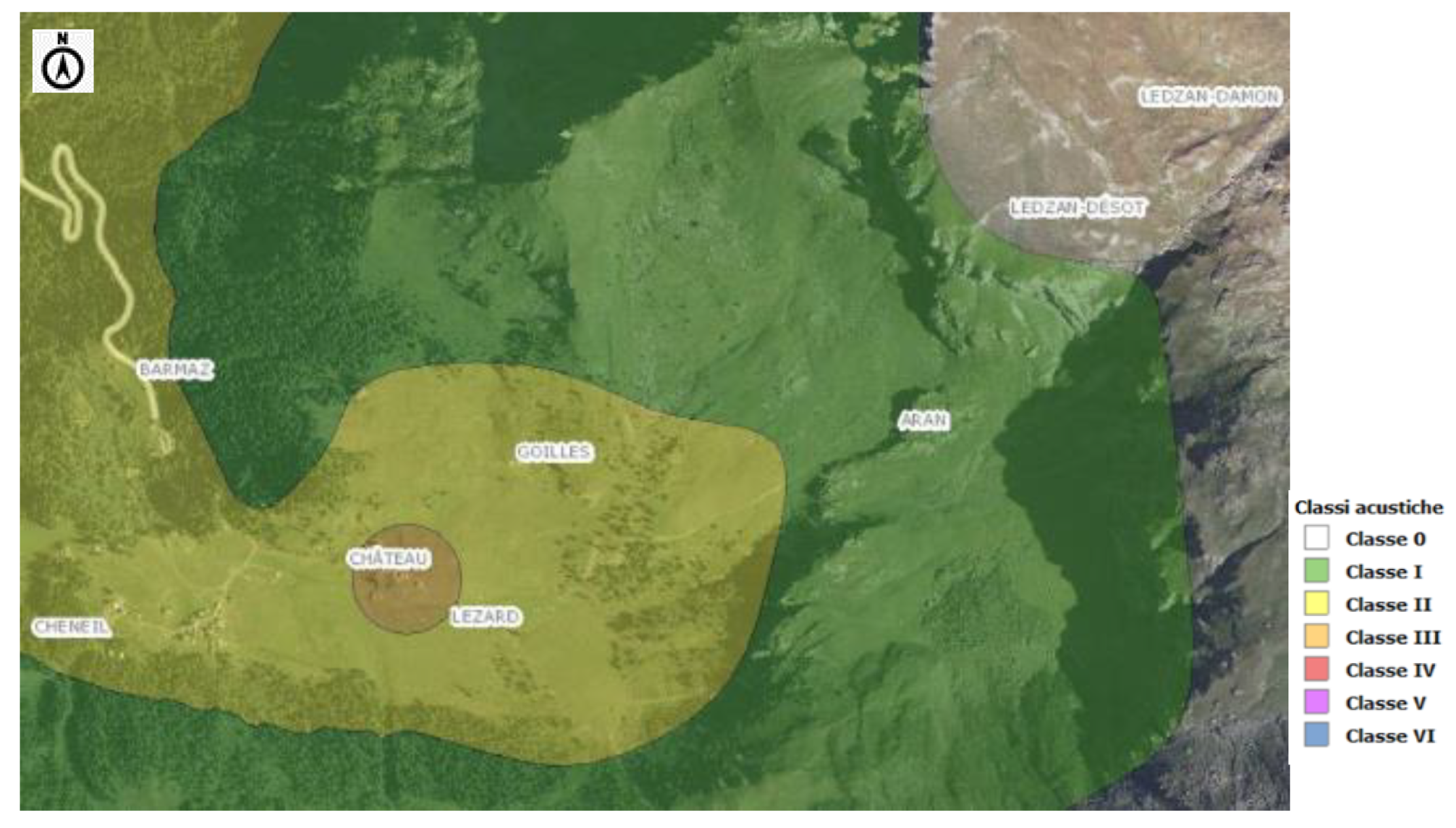
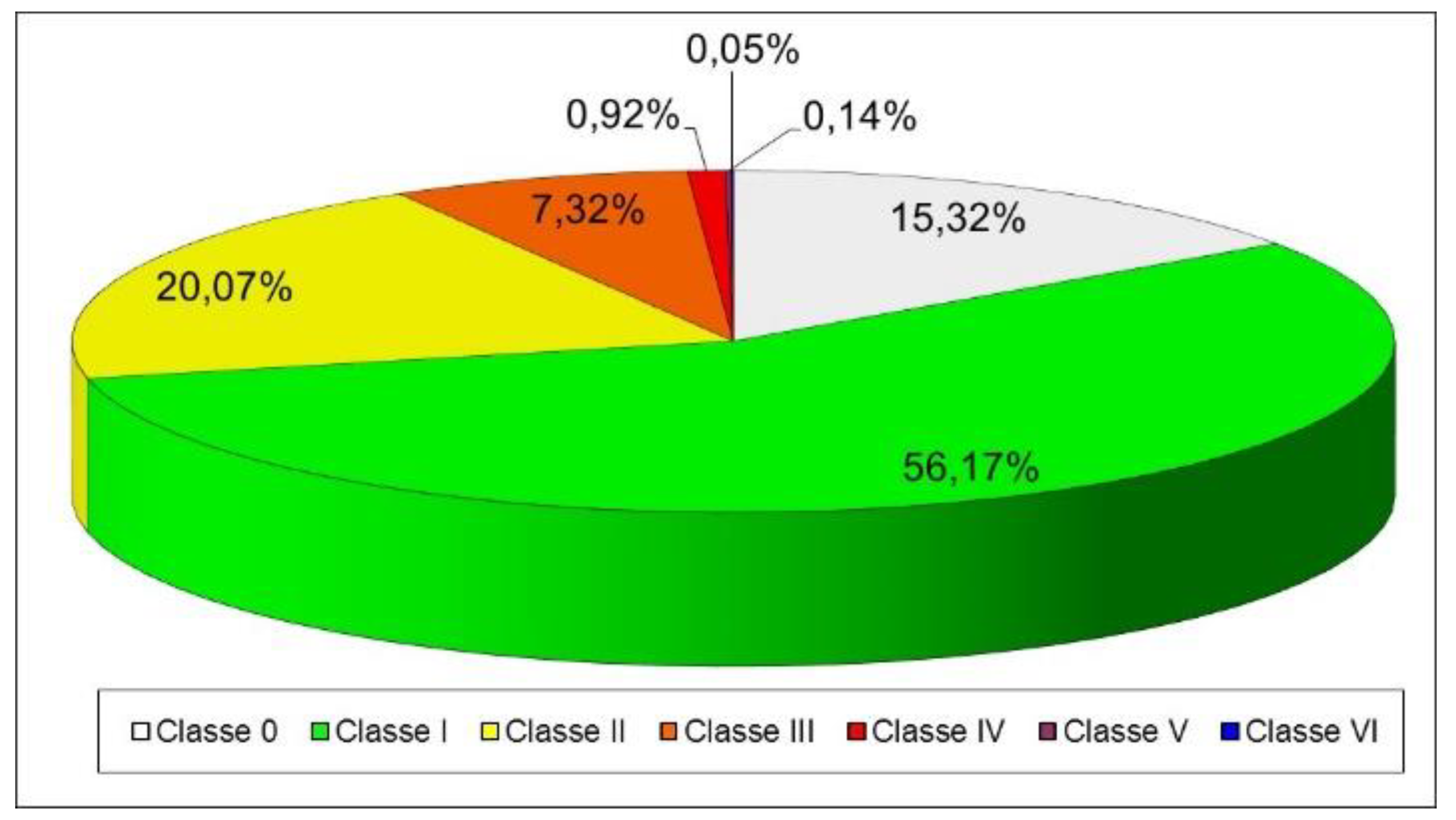
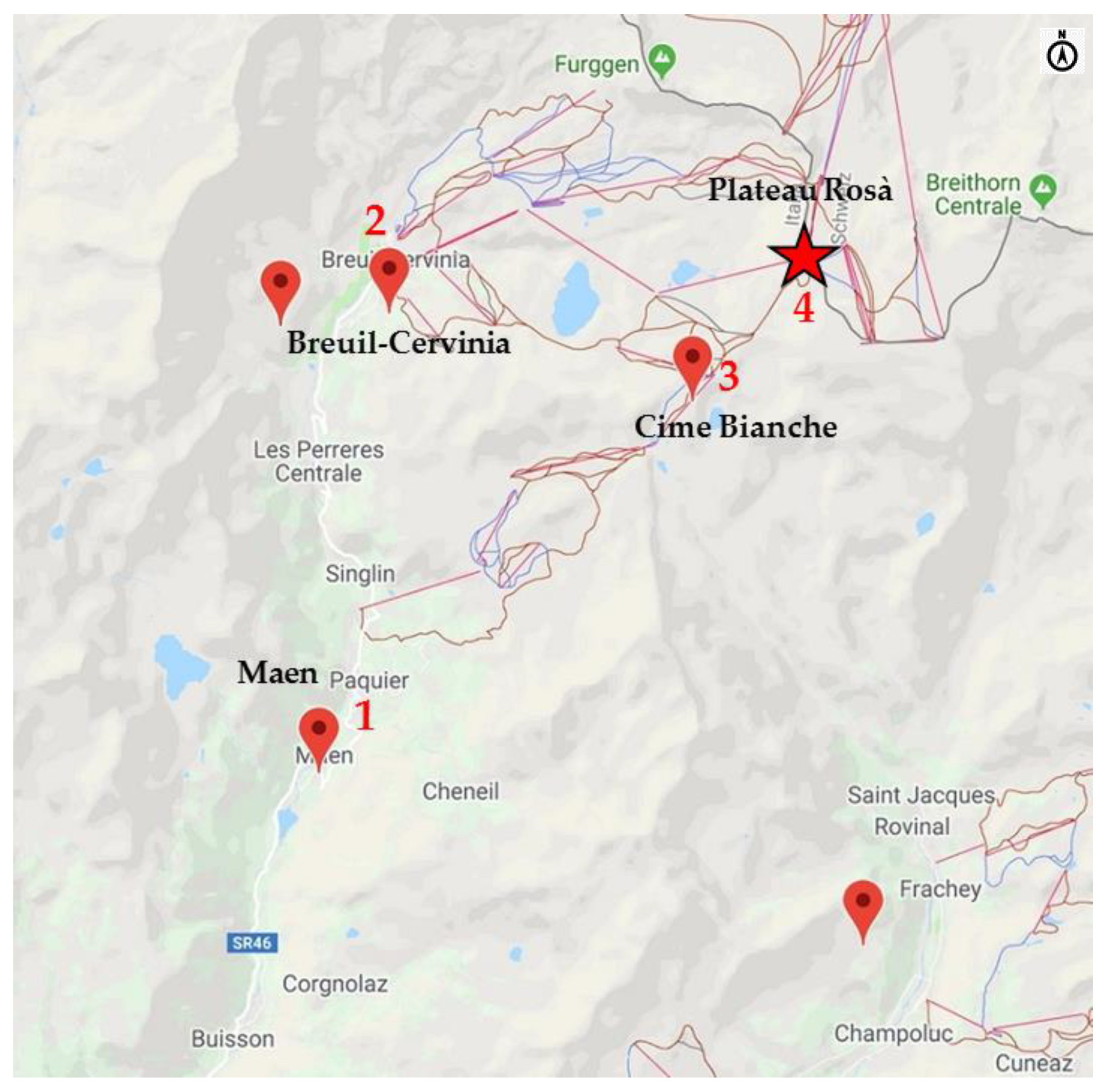
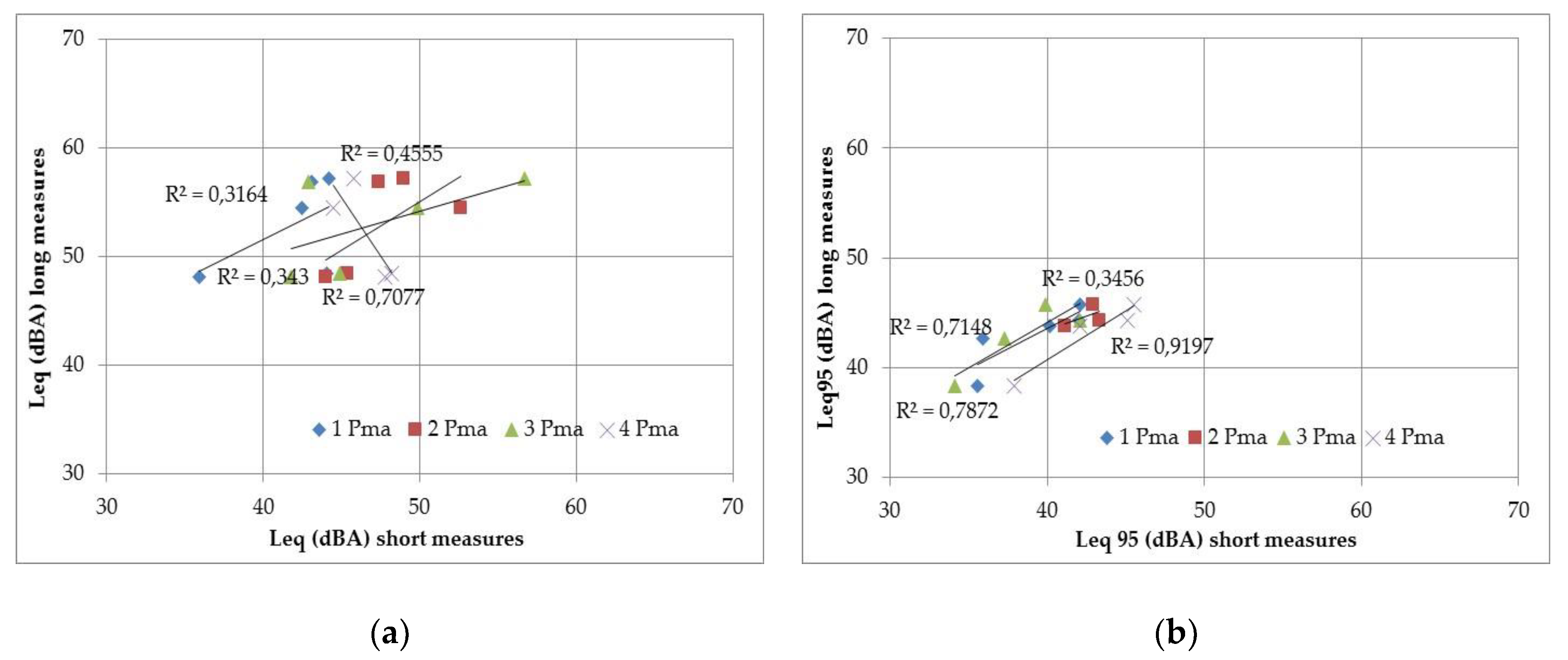
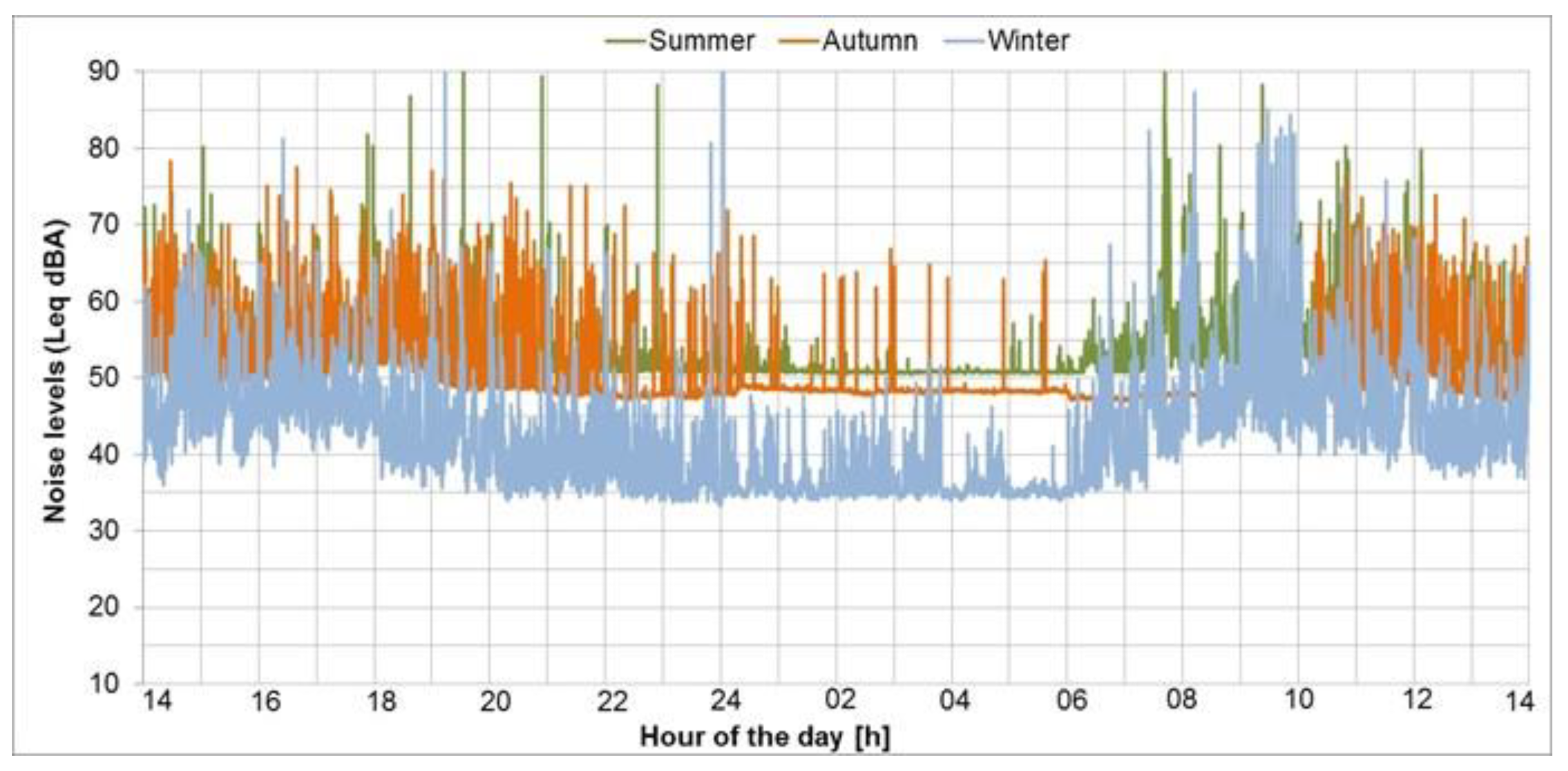
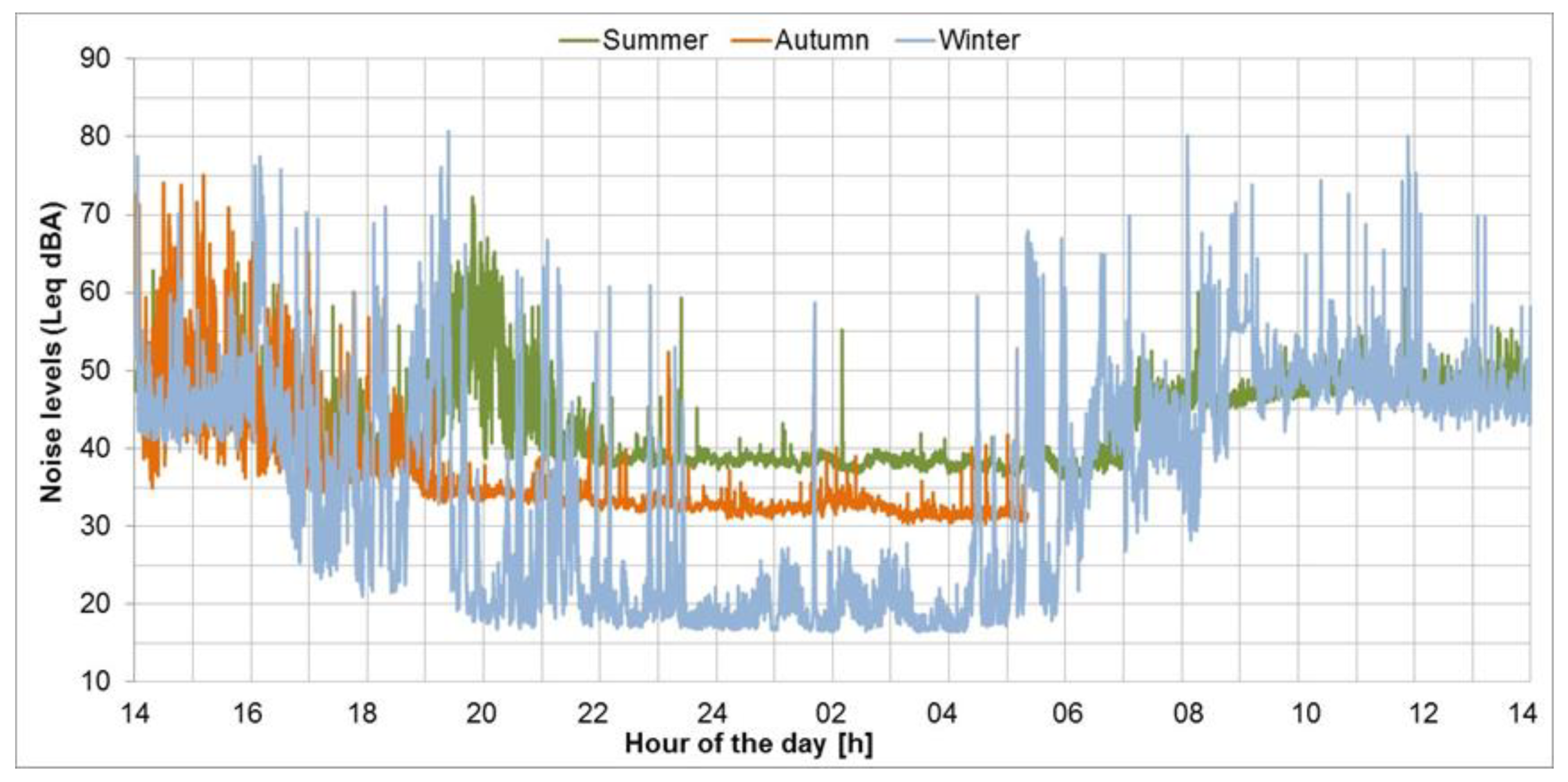
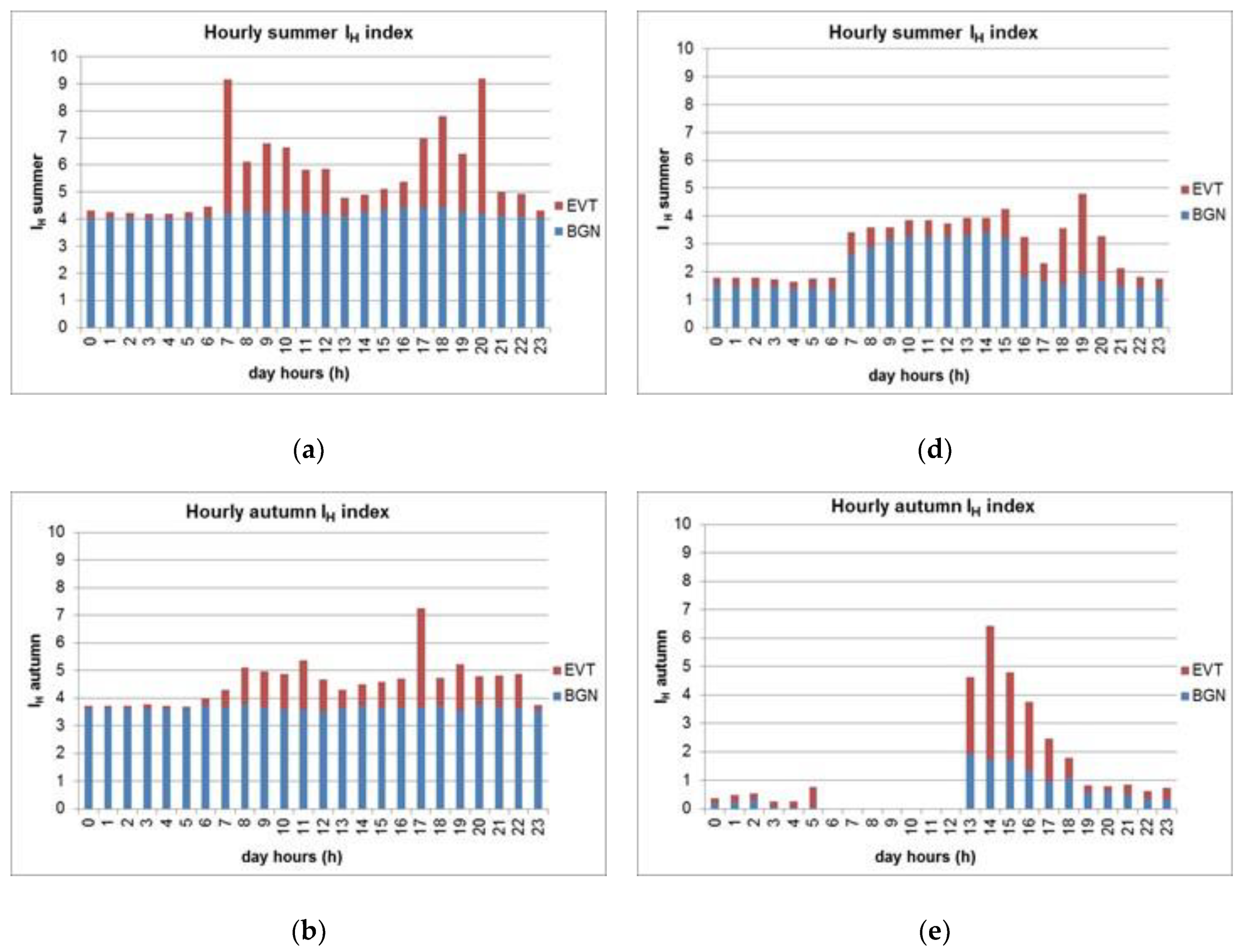
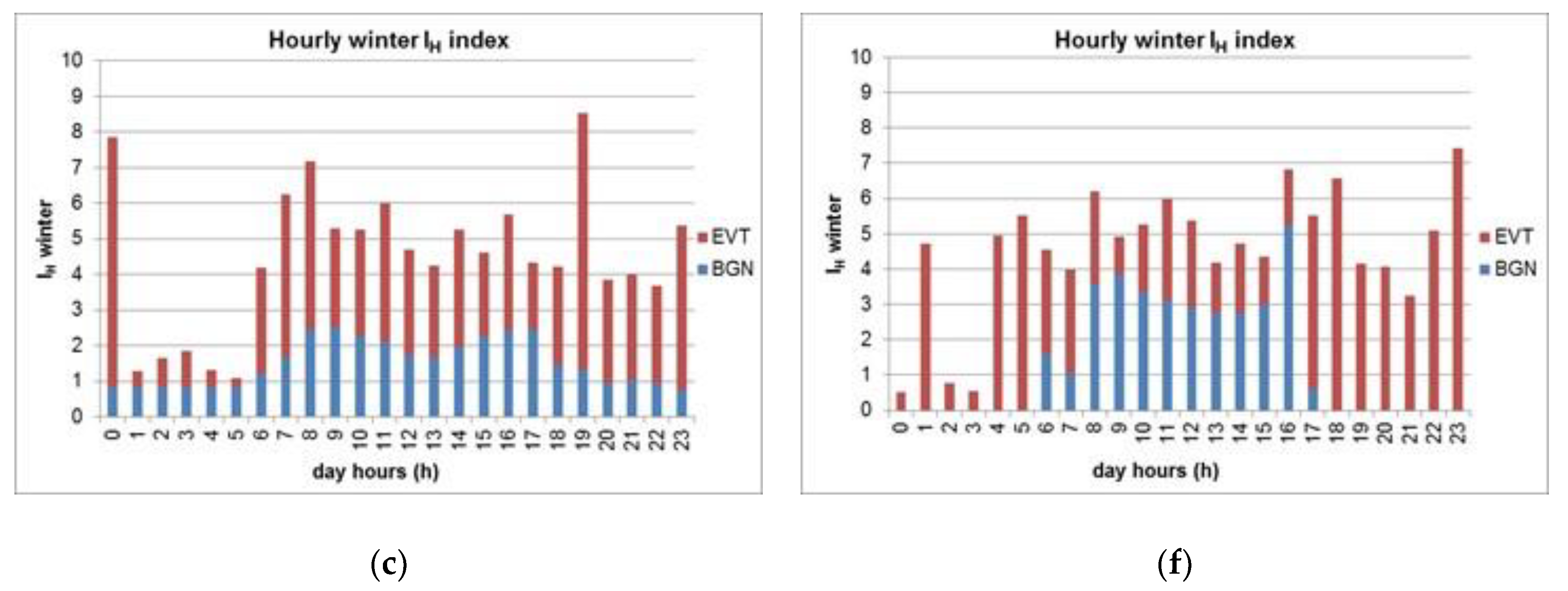
| Name of the Ski Centre | Start/End of the 2019–2020 Winter Season | Altitude (m a.s.l.) | Number of Ski Lifts | Length of the Ski Slopes (km) | |
|---|---|---|---|---|---|
| Min. | Max. | ||||
| Breuil-Cervinia, Valtournenche, Zermatt | from 26 October 2019 to 3 May 2020 | 1524. | 3883. | 53. | 350, of which 26.5 km is used for summer skiing |
| Chamois | 7–8 December 2019 and from 21 December 2019 to 29 March 2020 | 1815. | 2500. | 3 | 18 |
| Cheneil (Valtournenche) | / | 2105. | 3400. | / | 35 (only used for ski mountaineering) |
| Site | Measurement Point | Geographic Coordinates (WGS84 N/E) | Altitude (m a.s.l.) | Feature of the Site | |
|---|---|---|---|---|---|
| Chamois village | Fixed Cha | 45°50′17.16″ | 007°37′12.18″ | 1810 | Town hall balcony, main square |
| 1 Cha | 45°50′19.50″ | 007°37′15.06″ | 1820 | Centre of the village, road going to Lod | |
| 2 Cha | 45°50′18.30″ | 007°37′18.36″ | 1815 | Rural road going to La Magdeleine | |
| 3 Cha | 45°50′07.74″ | 007°37′15.84″ | 1815 | Panoramic terrace, Cableway | |
| 4 Cha | 45°50′17.52″ | 007°37′03.78″ | 1815 | Cemetery entrance, Cableway | |
| Site | Measurement Point | Geographic Coordinates (WGS84 N/E) | Altitude (m a.s.l.) | Features of the Site | |
|---|---|---|---|---|---|
| Lod Lake ski area | Fixed Lod | 45°50′40.28″ | 007°37′22.24″ | 2030 | Arrival station of the chairlift from Chamois |
| 1 Lod | 45°50′39.60″ | 007°37′17.52″ | 2030 | Picnic area next to the Lod Lake | |
| 2 Lod | 45°50′40.80″ | 007°37′17.52″ | 2025 | Area in the middle of the huts | |
| 3 Lod | 45°50′39.60″ | 007°37′27.54″ | 2030 | Panoramic terrace bar overlooking Chamois | |
| 4 Lod | 45°50′38.64″ | 007°37′19.38″ | 2025 | Courtyard of a hut near the chairlift | |
| 5 Lod | 45°50′45.72″ | 007°37′25.50″ | 2020 | Next moving walkways near lake | |
| Teppa ski area | Fixed Tep | 45°50′46.14″ | 007°38′00.62″ | 2250 | Chairlift at an intermediate station |
| Site | Measurement Point | Geographic Coordinates (WGS84 N/E) | Altitude (m a.s.l.) | Features of the Site | |
|---|---|---|---|---|---|
| Cheneil village and surrounding pastures | Fixed Che | 45°51′51.21″ | 007°38′38.36″ | 2100 | Courtyard in the “Bich”Alpine Refuge |
| 1 Che | 45°51′51.96″ | 007°38′36.72″ | 2095 | Courtyard in a hut near the Refuge | |
| 2 Che | 45°51′51.30″ | 007°38′31.44″ | 2110 | “Cheneil les Gorret” dirt road | |
| 3 Che | 45°51′55.92″ | 007°38′34.14″ | 2090 | Arrival station of the funicular from the car park | |
| Site | Measurement Point | Geographic Coordinates (WGS84 N/E) | Altitude (m a.s.l.) | Features of the Site | |
|---|---|---|---|---|---|
| high area | Fixed at school | 45°56′05.55″ | 007°37′56.36″ | 2060 | terrace of School |
| 1 Cer | 45°56′14.34″ | 007°38′06.54″ | 2085 | Breuil high part | |
| 2 Cer | 45°56′04.08″ | 007°38′04.92″ | 2055 | garden under cableway start | |
| 3 Cer | 45°56′01.92″ | 007°37′55.50″ | 2030 | ticket office square | |
| central area | Fixed at square church | 45°56′03.58″ | 007°37′48.70″ | 2005 | near Cervinia Church |
| 4 Cer | 45°55′55.02″ | 007°37′49.26″ | 2040 | area in front Hotel | |
| 5 Cer | 45°55′56.04″ | 007°37′38.46″ | 2000 | square at village entrance | |
| 6 Cer | 45°56′09.78″ | 007°37′52.68″ | 2015 | area near ice skating rink | |
| suburb area | Fixed near golf course | 45°56′09.19″ | 007°37′43.13″ | 2015 | near Cervinia golf course |
| 7 Cer | 45°56′10.32″ | 007°37′48.42″ | 2010 | the Cervinia main street | |
| 8 Cer | 45°56′16.14″ | 007°37′48.36″ | 2015 | car park at the end of the main street | |
| 9 Cer | 45°56′13.56″ | 007°37′36.60″ | 2015 | another car park | |
| Site | Measurement Point | Geographic Coordinates (WGS84 N/E) | Altitude (m a.s.l.) | Features of the Site | |
|---|---|---|---|---|---|
| The Plan Maison ski area | Fixed Pma | 45°56′28.83″ | 007°39′16.55″ | 2550 | Terrace of a cableway station |
| 1 Pma | 45°56′31.56″ | 007°39′19.08″ | 2540 | Along the ski run to Cervinia | |
| 2 Pma | 45°56′31.44″ | 007°39′22.68″ | 2555 | Terrace in front of the chairlift | |
| 3 Pma | 45°56′28.86″ | 007°39′25.32″ | 2545 | Area near the Plan Maison ski lift | |
| 4 Pma | 45°56′27.24″ | 007°39′18.84″ | 2550 | Terrace near a restaurant | |
| The Cime Bianche ski area | Fixed CBi | 45°55′47.50″ | 007°40′49.12″ | 2815 | Intermediate cableway station |
| The Plateau Rosà ski area | Fixed PRo | 45°56′06.72″ | 007°42′26.27″ | 3460 | Terrace of the final cableway station |
| Acoustic Class | Name | Characterization |
|---|---|---|
| Class I | Protected areas | Quietness represents a basic element for the use of such areas: hospital, schools, rest and leisure areas, rural residential areas, areas of particular urban interest, public parks, etc. |
| Class II | Residential use areas | Urban areas that are affected by local vehicular traffic, with a low population density, a limited presence of commercial activities, and the absence of industrial and craft activities |
| Class III | Mixed type areas | Urban areas affected by local or passing through traffic with an average population density, the presence of commercial activities, offices, a limited presence of craft activities, no industrial activities, and rural areas with agricultural machines |
| Class IV | Intense human activity areas | Urban areas affected by intense vehicular traffic, with a high population density and a high presence of commercial activities and offices, the presence of craft activities, areas close to major roads and railway lines, areas with small industries |
| Class V | Prevalently industrial areas | Areas affected by industrial settlements with just a few dwellings |
| Class VI | Purely industrial areas | Areas that are affected exclusively by industrial activities and where there are no dwellings |
| Type of Activity or Infrastructure | Specific Acoustic Classification | Extension Area (m) |
|---|---|---|
| Mountain farm pastures | Should be classified as class III for a radius of 100 m surrounding a farmhouse | Class II for 100 to 200 m, and class I for a pasture |
| Mountain huts | Should be classified as class II | with 100 m class I surrounding |
| Bars and restaurants | Their immediate surrounding (déhors and external appliances) can be included in class III | in class II for further 100 m and in class I from 100 to 200 m of distance |
| Cableway stations, ski lifts, and chairlifts | Should be classified as class IV in the periods they are open | to be extended to the relevant property areas |
| Ski slopes | Should be classified as class IV during the skiing activity period (but as a lower class in the other periods, depending on the use of the territory and the soundscape) | must be provided around the slopes and not exceeding 150 m |
| Remote high mountain areas | Class 0 Areas where the environmental sound levels must not be raised from artificial sources | There is no limit to the extension area around these areas, but it must border on with class I areas |
| Municipality | Site (m a.s.l.) | No. Long-Term Measurements | Hours of Long-Term Measurements | No. Short-Term Measurements | Hours of Short-Term Measurements |
|---|---|---|---|---|---|
| Chamois | Village (1819) | 3 | 120 | 48 | 8 |
| Lake Lod ski area (2029) | 3 | 168 | 27 | 5 | |
| Teppa high ski area (2248) | 3 | 180 | / | / | |
| Valtournenche | Urban center (2010) | 9 | 396 | 108 | 18 |
| Plan Maison station in middle ski area (2550) | 3 | 284 | 23 | 4 | |
| Cime Bianche high ski area (2820) | 3 | 308 | / | / | |
| Plateau Rosà station on the glacier (3460) | 3 | 180 | / | / | |
| Cheneil rural village and pasture (2101) | 3 | 55 | 35 | 6 | |
| Total | 30 | 1691 | 241 | 41 |
| Color of the Index IH | Quality Acoustic Environment | Day Period (06-22) | Night Period (22-06) |
|---|---|---|---|
| Red | Recognized by WHO for critical acoustic quality environments | IH ≥ 8 | IH ≥ 7 |
| Yellow | Environments where noise exceeds the recommended quality but remains under the recognized critical thresholds | 4 ≤ IH < 8 | 3 ≤ IH < 7 |
| Green | Good acoustic environments under the quality thresholds | IH < 4 | IH < 3 |
| Site | Daytime (06-22) | Nighttime (22-06) | ||||
|---|---|---|---|---|---|---|
| Summer | Autumn | Winter | Summer | Autumn | Winter | |
| Chamois village | 57.2 | 55.7 | 53.5 | 50.1 | 48.8 | 46.2 |
| Chamois-Lake Lod in the ski area | 54.0 | 36.6 | 53.9 | 49.7 | 29.5 | 28.3 |
| Chamois-Teppa, high area in the ski area | 38.7 | 31.5 | 48.8 | 25.9 | 23.7 | 22.7 |
| Cervinia-church square | 63.6 | 54.7 | 56.6 | 51.5 | 49.4 | 53.8 |
| Cervinia-Giomein place | 58.4 | 52.4 | 55.9 | 52.4 | 48.9 | 44.0 |
| Cervinia-main road | 58.0 | 54.9 | 55.9 | 47.0 | 42.4 | 44.8 |
| Plan Maison station in the middle of ski area | 47.5 | 49.8 | 54.6 | 38.5 | 32.3 | 44.5 |
| Cime Bianche-high ski area | 59.7 | 36.8 | 63.1 | 35.0 | 33.7 | 50.0 |
| Plateau Rosà station on the glacier | 49.0 | 55.4 | 64.5 | 40.3 | 57.0 | 47.9 |
| Cheneil-rural village and pastures | 42.5 | 53.2 | 35.7 | 51.2 | 45.5 | n.r. |
| Site | Day Period (06-22) | Night Period (22-06) | ||||
|---|---|---|---|---|---|---|
| Summer | Autumn | Winter | Summer | Autumn | Winter | |
| Chamois village | 50.8 | 47.5 | 44.3 | 48.4 | 47.3 | 44.3 |
| Chamois-Lake Lod in the ski area | 48.3 | 28.6 | 43.2 | 46.8 | 27.2 | 23.8 |
| Chamois-Teppa high ski area | 36.0 | 18.0 | 37.8 | 19.0 | 18.0 | 18.0 |
| Cervinia-church square | 51.3 | 48.3 | 40.0 | 50.1 | 48.0 | 34.2 |
| Cervinia-Giomein place | 52.0 | 47.5 | 40.5 | 51.3 | 47.4 | 38.1 |
| Cervinia-main road | 46.0 | 40.8 | 37.5 | 43.4 | 40.3 | 27.5 |
| Plan Maison station in the middle of ski area | 43.9 | 36.5 | 46.8 | 37.2 | 31.0 | 22.2 |
| Cime Bianche-high ski area | 45.6 | 30.9 | 50.2 | 32.8 | 29.7 | 35.3 |
| Plateau Rosà station on the glacier | 40.3 | 33.4 | 46.1 | 34.4 | 23.6 | 36.4 |
| Cheneil-rural village and pastures | 38.4 | 33.8 | 20.0 | 39.1 | 33.5 | n.r. |
| Site | Day Period (06-22) | ||||||||
|---|---|---|---|---|---|---|---|---|---|
| Summer | Autumn | Winter | |||||||
| bgn | evt | IH | bgn | evt | IH | bgn | evt | IH | |
| Chamois village | 4.2 | 1.6 | 5.8 | 3.5 | 2.1 | 5.6 | 2.9 | 2.3 | 5.2 |
| Chamois-Lake Lod ski area | 3.7 | 1.4 | 5.1 | 0.0 | 2.0 | 2.0 | 2.6 | 2.7 | 5.3 |
| Chamois-Teppa high ski area | 1.2 | 0.7 | 1.9 | 0.0 | 3.4 | 3.4 | 1.6 | 2.8 | 4.4 |
| Cervinia-church square | 4.3 | 3.1 | 7.4 | 3.7 | 1.6 | 5.3 | 2.0 | 4.2 | 6.2 |
| Cervinia-Giomein place | 4.4 | 1.6 | 6.0 | 3.5 | 1.2 | 4.7 | 2.1 | 3.8 | 5.9 |
| Cervinia-ringroad | 3.2 | 3.0 | 6.2 | 2.2 | 3.5 | 5.7 | 1.5 | 4.6 | 6.1 |
| Plan Maison-middle station ski area | 2.8 | 0.9 | 3.7 | 1.3 | 3.3 | 4.6 | 3.4 | 2.0 | 5.4 |
| Cime Bianche-high ski area | 3.1 | 3.5 | 6.6 | 0.2 | 1.5 | 1.7 | 4.0 | 3.2 | 7.2 |
| Plateau Rosà station on the glacier | 2.1 | 2.2 | 4.3 | 0.8 | 4.9 | 5.7 | 2.6 | 5.2 | 7.8 |
| Cheneil-rural village and pastures | 1.7 | 1.0 | 2.7 | 0.8 | 4.9 | 5.7 | 0.0 | 3.9 | 3.9 |
| Site | Night Period (22-06) | ||||||||
|---|---|---|---|---|---|---|---|---|---|
| Summer | Autumn | Winter | |||||||
| bgn | evt | IH | bgn | evt | IH | bgn | evt | IH | |
| Chamois village | 3.7 | 0.4 | 4.1 | 3.5 | 0.4 | 3.9 | 2.9 | 0.5 | 3.4 |
| Chamois-Lake Lod in the ski area | 3.4 | 0.7 | 4.1 | 0.0 | 0.6 | 0.6 | 0.0 | 1.1 | 1.1 |
| Chamois-Teppa, high ski area | 0.0 | 1.7 | 1.7 | 0.0 | 1.8 | 1.8 | 0.0 | 1.1 | 1.1 |
| Cervinia-church square | 4.0 | 0.3 | 4.4 | 3.6 | 0.4 | 4.0 | 0.8 | 4.9 | 5.7 |
| Cervinia-Giomein place | 4.3 | 0.3 | 4.6 | 3.5 | 0.4 | 3.9 | 1.6 | 1.5 | 3.1 |
| Cervinia ringroad | 2.7 | 0.9 | 3.6 | 2.1 | 0.5 | 2.6 | 0.0 | 4.3 | 4.3 |
| Plan Maison-middle station ski area | 1.4 | 0.3 | 1.8 | 0.2 | 0.3 | 0.5 | 0.0 | 5.6 | 5.6 |
| CimeBianche-high ski area | 0.6 | 0.6 | 1.2 | 0.0 | 1.0 | 1.0 | 1.1 | 3.7 | 4.8 |
| Plateau Rosà station on the glacier | 0.9 | 0.5 | 1.4 | 0.0 | 8.3 | 8.3 | 1.5 | 2.3 | 3.8 |
| Cheneil-rural village and pastures | 1.8 | 3.0 | 4.8 | 0.7 | 3 | 3.7 | / | / | / |
© 2020 by the authors. Licensee MDPI, Basel, Switzerland. This article is an open access article distributed under the terms and conditions of the Creative Commons Attribution (CC BY) license (http://creativecommons.org/licenses/by/4.0/).
Share and Cite
Tibone, C.; Masoero, M.; Berlier, F.; Tabozzi, G.; Crea, D.; Tartin, C.; Cappio Borlino, M.; Agnesod, G. Seasonal Variability of the Acoustic Climate of Ski Resorts in the Aosta Valley Territory. Environments 2020, 7, 18. https://doi.org/10.3390/environments7030018
Tibone C, Masoero M, Berlier F, Tabozzi G, Crea D, Tartin C, Cappio Borlino M, Agnesod G. Seasonal Variability of the Acoustic Climate of Ski Resorts in the Aosta Valley Territory. Environments. 2020; 7(3):18. https://doi.org/10.3390/environments7030018
Chicago/Turabian StyleTibone, Christian, Marco Masoero, Filippo Berlier, Giovanni Tabozzi, Daniele Crea, Christian Tartin, Marco Cappio Borlino, and Giovanni Agnesod. 2020. "Seasonal Variability of the Acoustic Climate of Ski Resorts in the Aosta Valley Territory" Environments 7, no. 3: 18. https://doi.org/10.3390/environments7030018
APA StyleTibone, C., Masoero, M., Berlier, F., Tabozzi, G., Crea, D., Tartin, C., Cappio Borlino, M., & Agnesod, G. (2020). Seasonal Variability of the Acoustic Climate of Ski Resorts in the Aosta Valley Territory. Environments, 7(3), 18. https://doi.org/10.3390/environments7030018






